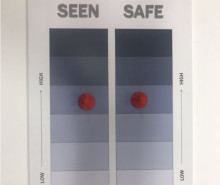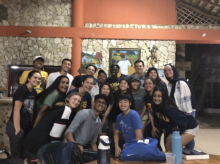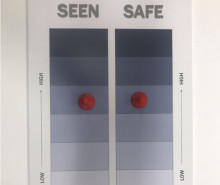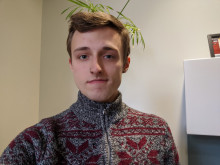Denise Leyton
Library Blogs
Showing 1 - 10 of 15 items
Results
for Date: March 2020

In three blog posts, the authors describe a multi-year library service design project. This last post describes the team’s prototyping and testing processes, and our resulting interactive exercise.

The Computer & Video Game Archive physical collection is closed, as is the Duderstadt Center. Our staff won't be answering our phone or returning calls while the building is closed, but feel free to reach out to us via email at video.games@umich.edu with questions or requests for remote consultations related to video game studies. We're happy to help. The gamer community is a tight-knit group, and we're thinking about you during this time of social distancing. We hope you stay safe, and hope you're able to visit us once we're able to reopen. For now, we hope you'll engage with us on social media and let us know how you're doing.

The Pre-Medical Club’s (PMC) Alternative Spring Break (ASB) is a health-oriented service and educational trip for students at the University of Michigan. Since its beginning in the early 2000s, PMC has worked with the Community Service Alliance (CSA) in the Dominican Republic to organize and plan the spring breaks each year. CSA is a multi-faceted organization which strives to empower communities through health initiatives, educational and youth programs, and a focus on supporting female community members. We have continued to partner with CSA throughout the years because of the positive effects we observe in the communities and because of the level of involvement they permit students to have.
Although CSA has many projects in multiple areas throughout the Dominican Republic, our group has chosen to orient our spring breaks around their health initiatives and educational programs. Additionally, the past four years we have been in the same province: Hato Mayor. Each year, the details of the project change, however the objectives remain the same. Following the goals of CSA, we hope to empower and build up communities in terms of health to a point where they can continue health practices safely and independently after we and CSA leave.
Our spring break this year focused on two main projects: water filter installation and bathroom construction. Before embarking on our journey, CSA provided us with the schedule and project goals. We aimed to install eight water filters and construct two bathrooms in two separate communities during our five days of work. Along with the manual work, we also allotted two afternoons of the trip to speak with school children about hand-washing and general hygiene tips. On the schedule were other events where we could learn more about the Dominican Republic and its health system and culture. These events included a tour of a cacao farm, dance lessons from a local dance group, and a visit to a local health clinic for a presentation and a Q&A session.
Although CSA has many projects in multiple areas throughout the Dominican Republic, our group has chosen to orient our spring breaks around their health initiatives and educational programs. Additionally, the past four years we have been in the same province: Hato Mayor. Each year, the details of the project change, however the objectives remain the same. Following the goals of CSA, we hope to empower and build up communities in terms of health to a point where they can continue health practices safely and independently after we and CSA leave.
Our spring break this year focused on two main projects: water filter installation and bathroom construction. Before embarking on our journey, CSA provided us with the schedule and project goals. We aimed to install eight water filters and construct two bathrooms in two separate communities during our five days of work. Along with the manual work, we also allotted two afternoons of the trip to speak with school children about hand-washing and general hygiene tips. On the schedule were other events where we could learn more about the Dominican Republic and its health system and culture. These events included a tour of a cacao farm, dance lessons from a local dance group, and a visit to a local health clinic for a presentation and a Q&A session.

The Renaissance and Medieval Manuscript Collection belonging to the University of Michigan Library consists of an impressive array of medieval and early modern manuscripts from multiple cultures and languages, including Greek, Latin, Armenian, and Ethiopian. Fortunately, many of the manuscripts within this collection have largely been left in their original bindings and most damages have gone untreated.

When the students go on winter break I go to Hacks with Friends (HWF) and highly recommend and encourage everyone who can to participate in HWF 2021. Not only is it two days of free breakfast, lunch, and snacks at the Ross School of Business, but it’s a chance to work with a diverse cross section of faculty, staff, and students on innovative solutions to complex problems.

In three blog posts, the authors describe a multi-year library service design project. This second post describes the research process used to develop our user experience tool.

Gender is a powerful social category that individuals constantly use to make sense of both themselves and those around them. The Western world splits people into two categories: woman and man. These two gender categories can be used to visually sort almost all things. Individuals constantly attribute masculinity of femininity not only to people, but to animals and objects, too. With this in mind, my thesis hoped to examine how individuals interpret the gender cues that others present, particularly those present in the face. Individuals who identify outside of the man-woman dichotomy are gaining increased visibility. The core question is how has the increasing visibility of the nonbinary community begun to change how people conceptualize gender, particularly in how they perceive the gender of others?

In three blog posts, the authors describe a multi-year library service design project. This first post describes the origins and goals of the assessment project.
•
With the help of 3D printer of Shapiro Design Lab, I completed my project of making a two part mold for a fishing lure.

Well the library has been shut down until at least March 30th. Read this post to find some ebook resources that you can use as entertainment during these few weeks of self isolation.